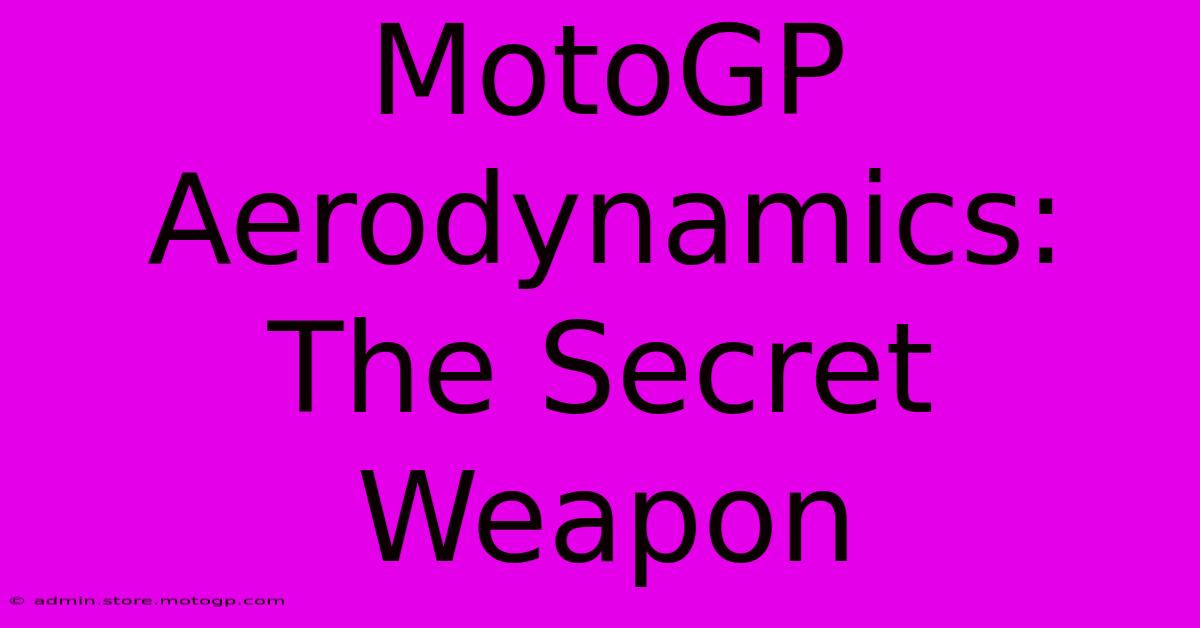MotoGP Aerodynamics: The Secret Weapon

Table of Contents
MotoGP Aerodynamics: The Secret Weapon
MotoGP racing is a brutal battle of speed, skill, and technology. While rider talent is paramount, the machines themselves are masterpieces of engineering, and nowhere is this more evident than in their aerodynamic design. Aerodynamics aren't just about speed; they're a secret weapon, influencing everything from cornering stability to outright top speed. This article delves into the crucial role aerodynamics plays in MotoGP success.
Understanding the Physics of MotoGP Aerodynamics
At speeds exceeding 200 mph, aerodynamic forces are significant. The bikes aren't just fighting air resistance (drag); they're also utilizing airflow to their advantage. Key aspects include:
-
Downforce: This is the crucial element. Wings and winglets generate downforce, pressing the bike to the track. More downforce means greater grip, allowing for faster cornering speeds and improved stability under braking. This is especially important when tackling high-speed corners.
-
Drag: While downforce is beneficial, drag is the enemy. It's the resistance the bike experiences as it pushes through the air. Teams constantly strive to minimize drag while maximizing downforce, a delicate balancing act. The shape of the fairing, the position of components, and even rider posture influence drag.
-
Airflow Management: Efficient airflow management is key. Teams use computational fluid dynamics (CFD) simulations to optimize the airflow around the bike, minimizing turbulence and maximizing aerodynamic efficiency. They analyze how air flows over the wheels, around the rider, and over the various aerodynamic devices.
The Evolution of MotoGP Aerodynamics
MotoGP aerodynamics have evolved dramatically. Initially, fairings were primarily about streamlining. However, the introduction of wings and winglets marked a significant shift. These devices, inspired by Formula 1 technology, drastically increased downforce, allowing for much faster corner speeds. The evolution continues, with teams constantly refining wing designs, experimenting with new materials, and exploring innovative solutions to improve performance.
Early days: Streamlined fairings for minimal drag. Modern era: Complex wings, winglets, and other aerodynamic devices for maximum downforce.
The Impact of Aerodynamics on Performance
The effects of sophisticated aerodynamics are far-reaching:
-
Cornering Speed: Increased downforce translates directly to higher cornering speeds. Riders can carry more speed through turns, shaving precious seconds off lap times.
-
Braking Stability: Downforce enhances braking stability, allowing riders to brake later and harder without losing control.
-
High-Speed Stability: At high speeds, aerodynamic stability is crucial. Advanced aerodynamic designs help maintain control and prevent unwanted wobbles or instability.
-
Overtaking: The ability to carry more speed through corners can give riders a significant advantage when overtaking rivals.
The Role of Technology and Data Analysis
Modern MotoGP teams rely heavily on technology and data analysis. CFD simulations, wind tunnel testing, and trackside data acquisition systems provide crucial insights into aerodynamic performance. Teams constantly analyze data to refine their designs and optimize their setup for each track.
Key technological advancements: CFD simulations, wind tunnel testing, and data acquisition systems.
The Future of MotoGP Aerodynamics
The quest for aerodynamic perfection is ongoing. We can expect further advancements in materials, design techniques, and data analysis to push the boundaries of MotoGP aerodynamics even further. Expect to see increasingly sophisticated aerodynamic solutions in the years to come. The battle for aerodynamic supremacy is a constant arms race, pushing the limits of both technology and rider skill.
Conclusion: More Than Just Speed
MotoGP aerodynamics are far more than just about achieving higher top speeds. It's about comprehensive performance enhancement – enhancing cornering, braking, and overall stability. It's a critical aspect of competitive advantage in this fiercely competitive world championship. The constant evolution of aerodynamic designs ensures that the battle for MotoGP supremacy remains thrilling and technologically captivating. The aerodynamic battle is a crucial part of the overall MotoGP spectacle, constantly pushing the boundaries of what's possible.

Thank you for visiting our website wich cover about MotoGP Aerodynamics: The Secret Weapon. We hope the information provided has been useful to you. Feel free to contact us if you have any questions or need further assistance. See you next time and dont miss to bookmark.
Featured Posts
-
Austin Gp Concert The Perfect Weekend Getaway
Feb 18, 2025
-
Club Si Austin F1 Where Legends Are Made
Feb 18, 2025
-
Experience The Evolution Of Racing Motorcycles
Feb 18, 2025
-
Yamaha Moto Gp News Rider Transfer Rumors
Feb 18, 2025
-
Moto Gp Bike For Sale Your Ticket To The Track
Feb 18, 2025
